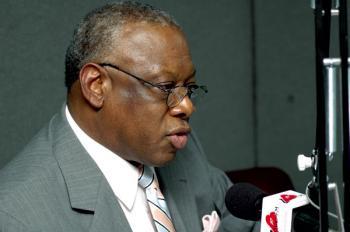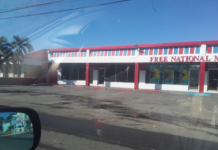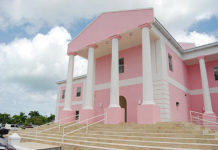
A COMPARATIVE EMPIRICAL REVIEW AND ANALYSIS
It is important in order to make the case for Mr. Christie’s record versus Mr. Ingraham’s record to outline the challenges they both met as leaders when they took office in 2002 and 2007 respectively. It is also interesting to note the different strategies they have employed to achieve their objectives.
It is my assessment based on my acute knowledge of what Christie met in the Bahamian economy in 2002, he was undoubtedly faced with more challenges than Mr. Ingraham had when he took office in 2007. He simply had more problems to overcome in an economy which was on the brink of collapse in many critical areas post 9/11 period.
I will endeavor to make the case based on the following empirical data why Mr. Ingraham is creating a myth surrounding his (grandiose) achievements during this recession, for which he really should be thanking Mr. Christie for handing him such a strong and buoyant economy which better prepared him for the eventual recession commencing in 2009. He had sufficient head room to borrow all the money he needed to devise a reasonable strategic plan to accomplish any objective that he wanted to in order to stimulate the private sector to create jobs and influence a more balanced economic performance, rather than concentrating his efforts in a one dimensional area, such as road building and infrastructure. Let’s begin as follows:-
The Bahamian Economy – 2002
In 2002 the Bahamian economy was struggling from the negative effects of the 9/11 meltdown of 2001 from the
Page 2
terrorists acts in the US which negatively impacted global travel.
· Our economy fell into a recession subsequent to this event with unemployment escalating from 9% in 2002, rising steadily to 10.8% by 2003.
· We in the Bahamas immediately felt the pain from this disaster by having a run on our tourism industry in terms of stop over tourists traveling to the Bahamas and the Family Islands with hotel occupancy rates plunging downwards to historic lows ranging from 10 – 20%. In short, tourists stopped travelling by airplanes from fear of terrorist attacks, which dramatically affected our air arrivals to the Bahamas.
· Mr. Christie inherited a whopping GFS Deficit of 3.4% from the FNM Gov. in 2002 – 213% higher than the 1.6% GFS the PLP left in 2007.
· As a consequence virtually every working person in the Hotel Industry, directly and indirectly, felt the immediate effects of this downturn, which was reflected in the rising un-employment and the slowdown in the sector and support related areas i.e. taxi drivers, straw vendors, restaurant workers, etc.
· The Government’s recurrent revenue experienced a decline by 10% to $875 mil from $975 mil in 2001. This resulted in putting pressure on our external reserves, which also declined to an average $340 mil – representing two months of import duty. It must be borne in mind that the required benchmark established by the IMF is three months’ worth of imports as an acceptable threshold.
Page 3
· Average liquidity in the system dropped to a low of $68 mil, perhaps the lowest since post-independence. The Central Bank had to restrict foreign companies operating in the Bahamas from remitting dividends to their Head Offices abroad in order to protect the fragile Bahamian dollar and foreign exchange quota.
· The outgoing FNM Gov. had to arrange to borrow US$125 mil as a standby credit to prop up the external reserves from falling below the two month import level. They also had an overdraft on their recurrent account with RBC that was in excess of $100 mil waiting to be paid down from this figure and other bills outstanding. It is ironic and interesting that this is the same $125 mil which Mr. Laing likes to refer to as being a part of the PLP’s debt of $800 mil, instead of the $650 mil that the Christie Gov. borrowed on their watch.
· The Bahamian economy was experiencing fiscal “hell” and on the brink of collapse.
· Adding insult to injury, there were no new foreign investors in the Bahamas or lined up at the bar to generate any kind of direct investments to stimulate our fragile economy.
Mr. Christie was faced with a real challenge as to how to
overcome this particular recessionary meltdown which threatened to be the worst since the recession of the 1940’s. Because the Bahamas derives 60-65% of its jobs from tourism, the most significant product we have to sell and because tourists were afraid to travel, this posed a major threat to our Country’s future. The big question therefore was – what were the options available to Mr. Christie and what strategy would he use to overcome this problem? Instead of complaining about what the global economy handed him in the Bahamas hampering him from improving the economy, he decided to devise a strategic plan to
Page 4
do something about it. Following are some of the actions coming out of that strategic plan:-
· He met with the local people in the hotel industry to discuss the problems and concerns and coming out of these particular meetings he was able to conclude that Mr. Ruffin on Cable Beach could play a prominent role in helping us through this difficult period. The economy received a shot in the arm from the sale of the Ruffin Hotel on Cable Beach asset to a local family group of investors in Lyford Cay, creating a catalyst for the Bahamar Development Project.
· Through the Hotel Corporation and Sir Baltron Bethel’s leadership, he met with dozens of potential foreign investors to discuss the potential of investing in the Bahamas in hotel related properties, second homes and other types of major real estate investments. He then framed a strategic plan called – “Anchor Investments” for each Family Island to give them a fighting chance to stabilize their local economies and create spin off investments and jobs.
· He also contracted with major potential hotel owners and other major property developers to invest billions of dollars on the Family Islands and New Providence.
Mr. Christie’s strategy eventually paid great dividends! From 2002 to 2004 Mr. Christie was able to sign Heads of Agreements for major investments in the Bahamas, totaling somewhere between a whopping $12 and $15 bil, including the likes of Albany, Bahamar, Atlantis Phase 3, millions of dollars in New Providence, Abaco, Eleuthera, Mayaguana, Exuma, San Salvador, Grand Bahama, etc.
By the time the PLP left office in 2007, the revenue had increased to $1.4 bil and the Country was able to pay its bills, stabilize its
Page 5
external reserves position significantly and allow Banks to repatriate their profits to their Head Offices.
As an impetus to this strategy he created a stimulus for the local economy by causing a reduction in the prime rate (from 6% to 5.5% in 2005), electricity tariff rates by 7 – 12%, real property taxes and incentives for first time home buyers for up to $250,000. Mr. Christie could easily have found a convenient way to raise taxes, but he refused to put this burden on the backs of
Bahamian people, at a time when they were already suffering from the shocks of this recession. In fact, at no time during his tenure did he resort to raising taxes to generate more revenues.
Another major decision was made to establish an Airport Management company to redesign and produce a new international airport by contracting with a Canadian management company to achieve this objective and to manage the company, which was set up to be a wholly owned Government corporation providing its own revenues and funding. This deal was executed by James Smith, former Minister of Finance and Glennis Hanna-martin, former Minister of Transport and was handed to the Ingraham administration in 2007 to finalize.
I. The Robust Economy Mr. Christie created as a result of his Strategic Plan and Anchor Projects
As a result of these activities, the Bahamian economy experienced a tremendous boom in virtually all critical areas commencing in 2004. This package of incentives was the catalyst which created this turn around in tourism, foreign investments as well as local investments. In the tourism sector stop over visitors started to return and the construction boom resulted from the high level of foreign investments generated throughout the economies
Page 6
of New Providence and the Family Islands as major touristic oriented and commercial properties were being constructed creating major anchors and spin off effects on many Islands. Some of the major highlights are as follows:-
· The Hotel Industry took off and recorded record levels in profits, occupancy rates, room rates and ADR.
· The tourism product soared to record levels, especially stopover visitors creating record levels of 1.6 million in 2005 and 2006 and 1.527mil in 2007 and a record level of per capita expenditure of over $2 bil.
· Mr. Christie brought the Bahamian economy back from depths of economic ‘hell” around 2004 and created the best produced economic results in the history of the Bahamas from that period all the way through to 2008.
· It was not unusual for ordinary staff in the hotel sector to earn $800 to $1,000 per week.
· This buoyancy brought a record level of home ownership, construction starts and completions.
· Employment soared to record levels with an unemployment rate in New Providence reaching a historic low in 2006 of 6.7% and the family Islands were experiencing the same kind of economic boom, as anchor investment projects were popping up all over the ground.
· The construction sector was operating on all cylinders on both the Family Islands and New Providence during this particular boom. It was normal for construction workers to earn good salaries from $800 to $1,500 per week, because of the shortage of qualified workers in this Sector. Consequently, the Country had to resort to importing foreign workers to fill some of the void in the industry. The record will show that the Bahamas created over 22,000 jobs during
Page 7
this period and thousands of other construction jobs during the $1 billion Phase 3 Atlantis Project followed by the demand for 1,000 workers for the Albany project coming on stream in 2007.
· Following the construction phase, 1200 sustainable jobs were created by Atlantis during the period April to July 2007 to staff the newly established Phase 3 property.
· The Bahamian economy was not only the best performing in the Caribbean, but one of the best in the World, with the unemployment rates of 7.6% in 2006 and 7.9% in 2007 ranking 9th in the World at that time. The Bahamas became the hottest ticket in the Caribbean and Latin America, in terms of foreign direct investments. There was no other destination in the Caribbean or Latin America to match these billions of dollars in FDI being pumped into the Bahamas to the tune of $4 bill during Mr. Christie’s term.
· Consequently, our GDP grew by $2.5 – $3 bil and direct debt to GDP in 2007 was recorded at 30% while the National Debt to GDP was a strong 35%. It must be remembered that the GDP was adjusted in 2011 by DOS, which dramatically upgraded these numbers retroactively from 2005 – 2011.
· This boom period carried over into 2008 during Mr. Ingraham’s tenure. In fact, the highest ever FDI achieved in our history happened in 2008 in the amount of US$1.1bil.
· Revenues peaked in 2008 to a new record high of $1.45 bil., which signaled that the economy was still very heated and headed for a better year than 2007. However, according to S& P, Mr. Ingraham tampered with this growth by his now famous “Stop, Review and Cancel” intervention, which slowed down the economy in the second half, further induced by the Wall Street meltdown in Q-4 2008. However,
Page 8
the official recession in the Bahamas took place in “2009” not 2008, as some would have you believe.
Other Achievements
§ Introduction and approval of National Health Insurance Legislation by Parliament.
§ Urban Renewal policing program, which was very effective from all accounts.
§ Urban Renewal Second Chance Program for youth
§ National Youth Initiative
§ Preparatory work towards university status for COB by 2009, obviously abandoned under the Ingraham administration.
Other Challenges faced by Mr. Christie on his Watch
If the challenge of 9/11 was not sufficient on his watch, he also experienced another three perfect storms (hurricanes):-
The names were Hurricane Frances on September 4, 2004: Hurricane Jeanne on September 25, 2004 and Hurricane Wilma on October 24, 2005, which badly interrupted the tourism product in Northern Bahamas particularly Grand Bahama, Abaco and many other Islands including New Providence. The damages created as a result of these hurricanes cost the Country hundreds of millions of dollars, but despite these high costs, Mr. Christie’s economic success still prevailed in producing historic economic
results, evidenced by the positive carryover all the way to 2007 and 2008.
Another challenge was the WTO travel restriction imposed on Caribbean countries involving visa related issues.
Page 9
As a reward for Mr. Christie’s administration’s strong and historic economic performance, in May 2006 Moody’s upgraded the Bahamas to a AA1 status, the highest achievement in the Country’s history in this area.
This is a clear indication of how Mr. Christie met his challenges as measured by the results of this prestigious award by such a highly respected credit rating agency such as Moody’s.
These results are now a matter of irrefutable historical record and are now etched in the record of the Hansard of the House of Assembly for future generations of Bahamians to review as a pivotal piece of stellar fiscal accomplishments unmatched by any previous administration in the Country’s history. This is a clear indication that Mr. Christie has been the victim of bad public relations and lies told about his record by his detractors, including Mr. Ingraham.
II. Ingraham’s Administration (2007 – 2012)
It is now a matter of record that Mr. Ingraham was handed a “golden hand” by the Christie administration in terms of the performance of the economy in 2007, with most key indicators headed in a strong positive direction i.e. FDI’s, GDP growth, revenue growth, strong debt management structure, strong construction sector, strong tourism sector, strong financial services sector, which recorded record profits during the Christie
era, strong retail business sector with unemployment in the low single digits on all of the Islands, especially New Providence, Abaco, other Family Islands and around 8 – 9% in Grand Bahama. Total unemployment in the Bahamas in 2007 was 14,500. Total unemployment today in the Bahamas is approx.
42,000 (unemployed and discouraged workers).
Page 10
On Ingraham’s watch the following took place:-
Record level youth unemployment of 34% in 2012 based on recent census.
Record level job losses of 27,000 from 2009 – 2012
Record level unemployment of 42,000 (unemployed and discouraged workers).
Record level murders and crime in general.
Record level social decay and lawlessness in the Bahamas.
Record level home foreclosures.
Record level high taxation across the board in 2011 creating more depressed economic conditions.
Record high cost of living increase and high CPI indexes creating a major decline in disposable income of middle class and poor.
Record level misery index of 150,000 Bahamians representing 43% of the total population of the Bahamas.
Record level high in electricity bills
Record level high in gas costs in 2007 and 2012 at $6 per gallon
Record level of persons who were unable to pay utility bills and record cut-offs (5000 – 6000 customers)
Record level national debts, increasing by 75% or $2.1 bil by fiscal year end 2012.
Record level annual deficits averaging close to $400 mil per annum and recurrent deficits of $131 mil average annually
Record level of Bank interest costs
Record level negative growth in GDP of 4.7% from 2008 to 2011. Although the FNM is projecting a 2.8% GDP in 2012, there is nothing in the Bahamian economy to support this proposition. In fact, there is more evidence to support a negative growth, based on the high cost of oil, electricity and
Page 11
CPI rates, running higher than their budgeted rates of 2% in 2011 and 1.4% in 2012. Moody’s, who projected a 2.3% GDP growth for 2012 recently advised that even this number is considered overly optimistic. The Central Bank as late as October 2011 forecasted a decline in the Gov. GDP growth
A 27 year low in stop over arrivals from 2009 – 2011
Under performing and high unemployment in the construction industry with no medium term prospects for building houses, which are being foreclosed on at record levels.
No growth and new jobs in the retail business sector, which has been depressed since 2009. No new net jobs created in the Tourism sector since 2008 due to three consecutive years of mediocre stop over performances at a 27 year low.
Considering the Tourism sector is responsible for 60% of all the jobs created in the Bahamas, this has been a major disappointment and explains why unemployment remains at 42,000.
· The Bahamas currently has the highest rate of unemployment in the Caribbean among its peers.
· The BTC sale fiasco, selling 51% of the shares was a very unpopular move by the FNM Gov. and is considered a major mistake by most of the Country’s financial professionals.
· Financial Services sector losing a net of 300 jobs from 2007 to 2011 to other jurisdictions.
· Record level oil bills in 2008 of $1.1 bil and 2011 $805 mil.
· Record level increase in NIB costs during the past two years.
· No strategic plan in place to stimulate the economy and to train Bahamians across the board
· Record level down grade by two rating agencies in 2009 and 2011 – Moody’s and Standard and Poor, with three
Page 12
downgrades in 2009 and 2011as a result of fiscal mismanagement and excessive borrowings and deficits.
· Major neglect of Grand Bahama’s economy by the FNM, resulting in the highest unemployment on record of 22% and conversely investing more money in Abaco than all the other Family Islands combined and as a result all the other Islands have suffered undue hardship.
· The latest example of his fiscal mismanagement is in the handling of the road building project, which will cost the tax payers at least $100 mil in cost overruns from inefficiencies, corruption and remedies to business persons for damages as a result of the poor fiscal and technical management of this project, creating thousands of unemployed Bahamians and costing the tax payers more debts to cover these inefficiencies.
The IDB in a report to the Ingraham administration during the past two years advised him that he and his Government were creating large fiscal imbalances and deficits because they lacked the experience in managing for results, budgetary and planning practices. This explained why when the crisis came in 2009 he failed to provide a strategic plan to manage his way out of this recession with astute fiscal management of scarce resources and a strategic plan to prioritize stimulating the economy, creating jobs and improving the Country’s revenue stream. He spent too much “unfocussed efforts” in concentrating on only building roads and infrastructure and not sufficient resources in stimulating the private sector, training people and creating new jobs.
His fiscal inefficiencies caused him to impose massive taxes in 2011 to achieve his selfish political objectives. It was the wrong strategy to employ in a recession and did more damage than good to the average Bahamian family. Any fool can borrow
Page 13
money, but it takes astute money management skills to achieve efficient results and adequate returns.
Consequently he failed to meet the challenges facing him successfully, unlike Mr. Christie, whose innovative ideas and investment decisions created the opposite results. These are the facts, based on Christie’s and Ingraham’s comparative records. Which of these two records had more challenges? Which of these two records were more successful and which of these two records you would give a second chance to manage the economy? It should be obvious by now that Mr. Ingraham badly mismanaged the Bahamian economy without a strategic plan to improve the lives of Bahamians. The Bahamas cannot take another five years of this dictatorial one man show in an era that requires consultation, new ideas and input from the best minds in the Country in trying to build a nation called the Bahamas.
Ingraham’s twentieth century management style and modus operandi are considered “passé” in today’s twenty-first century Bahamas. He suddenly finds himself out of touch with the educated and independent minded Bahamians. He needs to retire or be retired at this time in the Nation’s best interest. Four more years of his divisive tactics and dictatorial tendencies are too regressive for the Country to continue to grow.
Prepared by Al Jarrett CMG, MBA
and aided by Elcott Coleby
March 18, 2012






![A Con Artist [RACIST] wants Bahamians to fight progress – WELL, WHAT IS THIS?!](https://www.bahamaspress.com/wp-content/uploads/2025/07/Toby-Smith-218x150.jpg)
